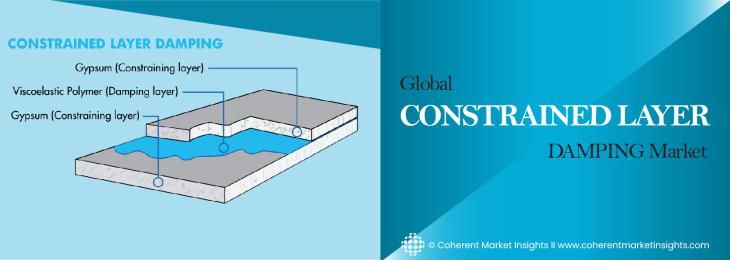
The automobile industry is continuously seeking to reduce vehicle weight while improving noise, vibration, and harshness performance. This raises the demand for lightweight acoustic materials, treatments, and components to improve vehicle acoustic performance. CLD is made up of stiff viscoelastic material layers that assist disperse vibratory energy in the structure by sheer deformation of the viscoelastic layer. As a result, CDC is proving to be an effective strategy for controlling throbbing and sound in these structures, which is increasing demand for CDC. This is a primary reason driving the limited layer damping market's growth. A detailed review of the report's restraints depicts the contrast to drivers and allows for strategic planning. Factors that overshadow market growth are critical because they may be used to design diverse strategies for seizing the rich chances that exist in the ever-growing market. In addition, insights of market experts' viewpoints have been used to better comprehend the industry.
According to Coherent Market Insights, Global Constrained Layer Damping Market was valued at US$ 429.83 Mn in 2021 in terms of revenue, exhibiting a CAGR of 6.35 % during the forecast period (2022 to 2030).
Prominent Companies in the Constrained Layer Damping Industry:
1. Sika Ag
Sika AG manufactures and sells speciality chemical-based products. The majority of the company's revenue comes from the construction industry. Sika's products are used primarily for bonding and sealing. The firm produces additives for concrete, sealants for roofing and flooring, waterproofing systems, and light-weighted components for the automotive and wind-generation industries. The company's reportable segments are primarily based on geography: Europe, the Middle East, and Africa; the Americas; Asia-Pacific; and global business. The EMEA segment generates the majority of revenue. The company was founded in 1910, headquartered in Switzerland.
2. Trelleborg Ab
Trelleborg AB manufactures products to seal, damp, and protect critical applications for a multitude of industries. It focuses on improving functionality, productivity, and minimizing energy waste for customers in transportation equipment, aerospace, and other industrial markets. Western Europe is an important region for the company and accounts for approximately half of total revenue.segments. The company was founded in 1905, headquartered in Trelleborg, U.S.
3. Henkel Ltd.
Henkel was founded in 1876. People around the world trust Henkel’s brands and technologies. In the fiscal year 2015, the company reported sales of approx. 18 billion euros and an operating profit of 2.9 billion euros. The DAX-30 company has its headquarters in Düsseldorf, Germany. Henkel is thus one of the most international German companies
4. Nitto Denko Corporation
Nitto Denko Technical Corporation is a developer of novel electric, organic, inorganic, and hybrid materials. The company was founded in 2000, headquartered in Oceanside, U.S.
5. Autoneum
Autoneum is a manufacturer of multifunctional and lightweight components for automobiles. They offer products for engine covers, interior floors, underbodies, body treatments, measurement systems, and specialist articles. The company was founded in 2011, headquartered in Zurich, Switzerland,
6. American Acoustical Products
American Acoustical Products designs and manufactures noise and vibration control products. The company was founded in 1963, headquartered in Massachusetts, U.S.
7. Soundown Corporation
Soundown Corporation manufactures and supplies noise control materials for the marine, architectural, and industrial industries. The company was founded in 1983, headquartered in Massachusetts, U.S.
8. Vibracoustic Gmbh
Vibracoustic is a leading global automotive Noise company located in Ligonier. The company was founded in Indiana, U.S.
9. 3M
Developer of technology platforms including Adhesives, Abrasives, Light Management, Microreplication, Nonwoven Materials, Nanotechnology, and Surface Modification the company was founded in 1902, headquartered in Saint Paul, U.S.
*Definition- Constrained Layer Damping (CLD) is a technology used to reduce vibrations in different machineries such as ship constructions, propeller vibrations, mounted machinery, and so on. It is constructed of two stiff sheets with low damping qualities.





